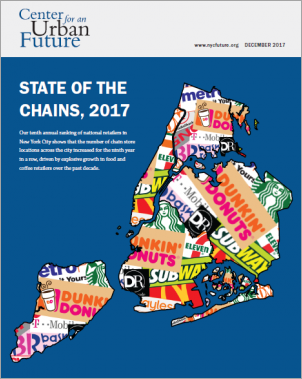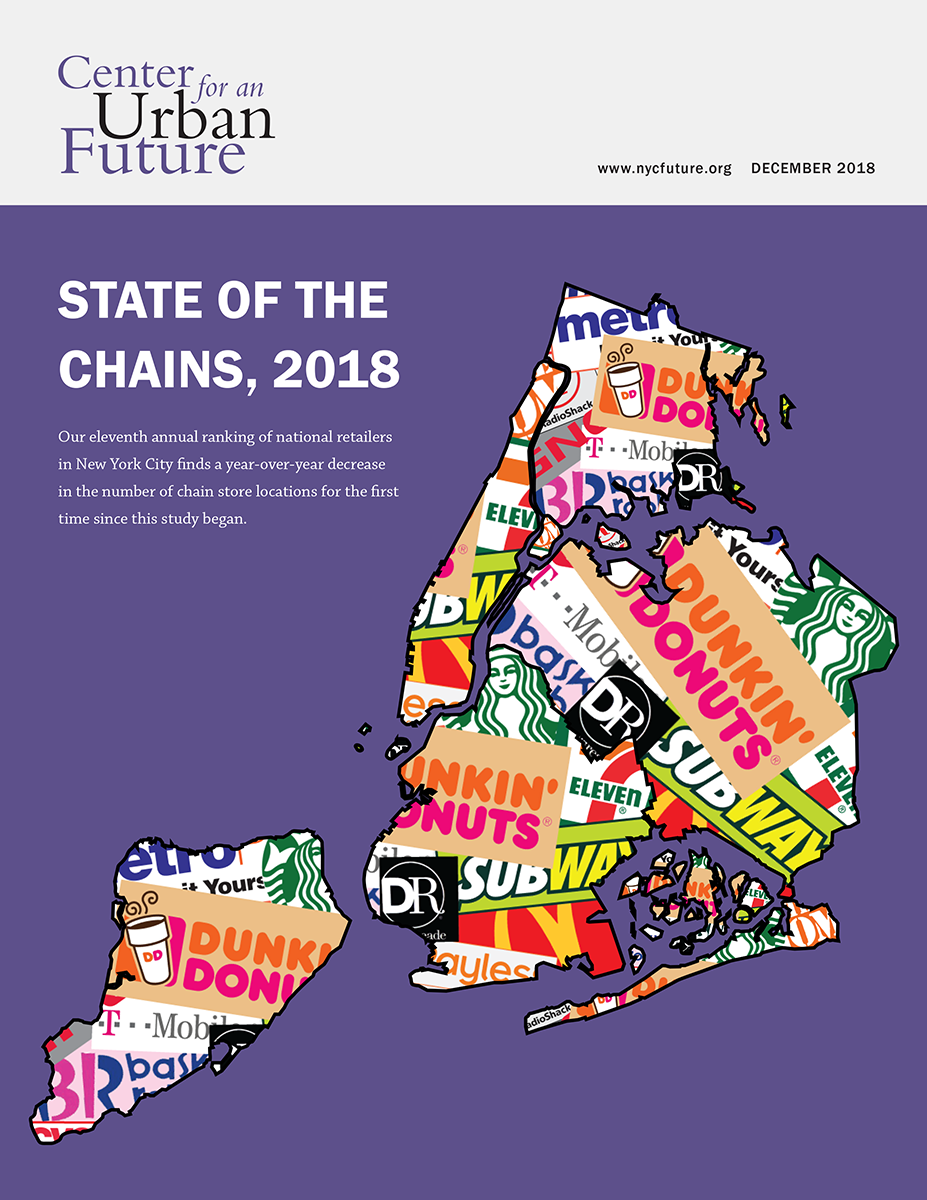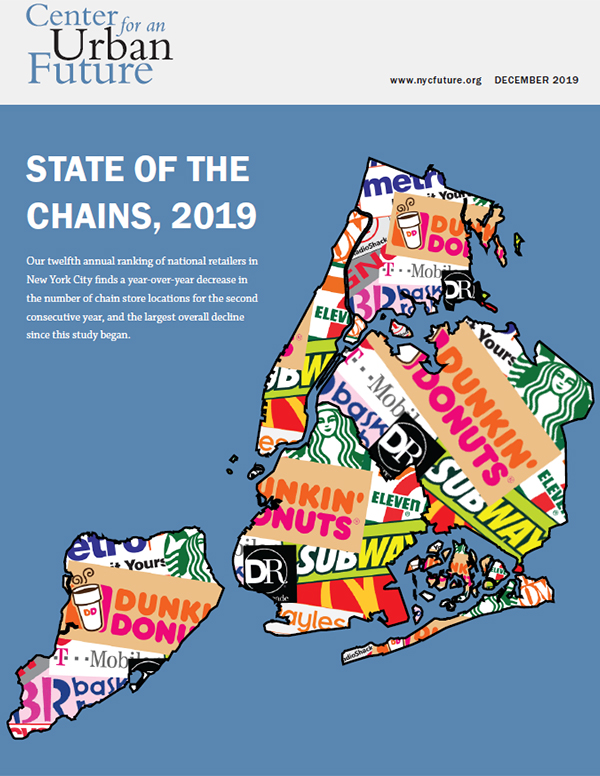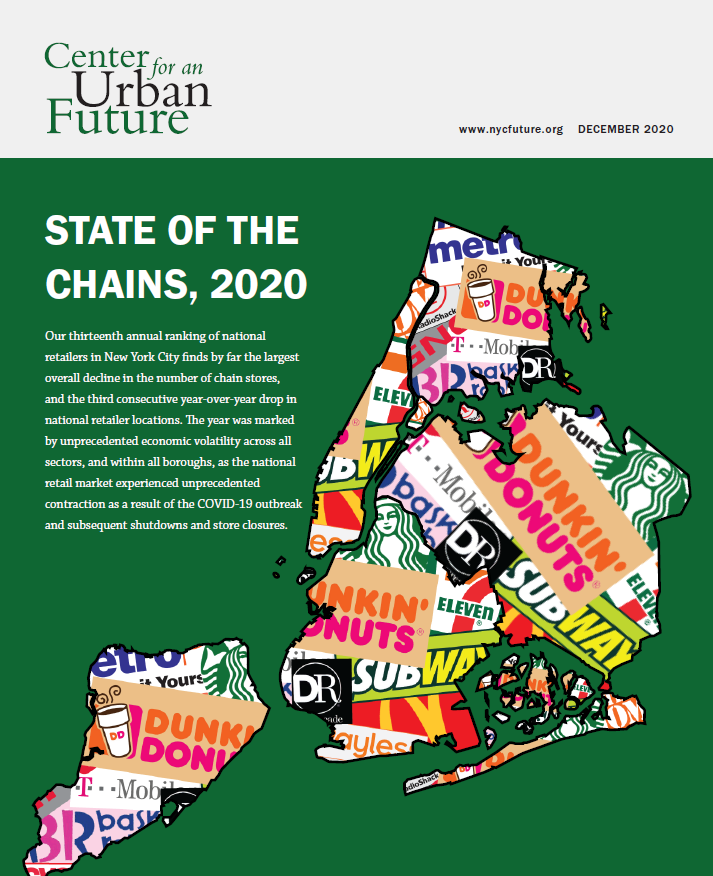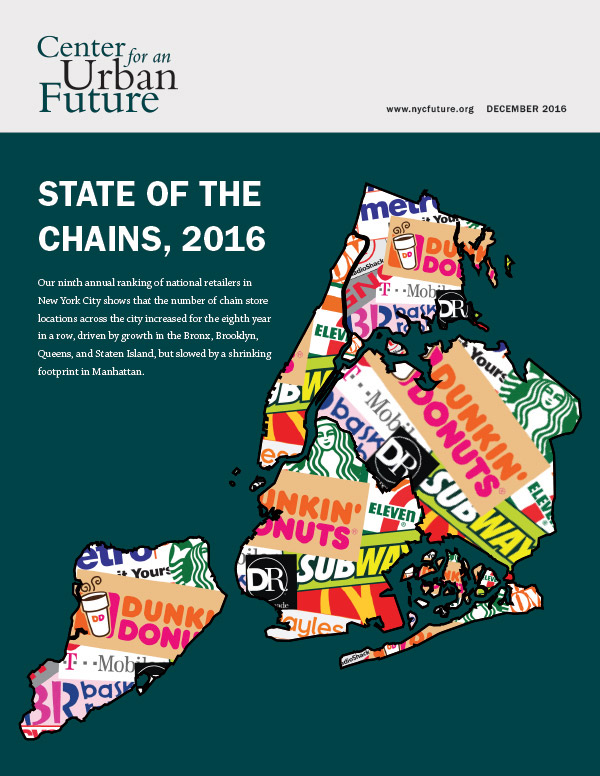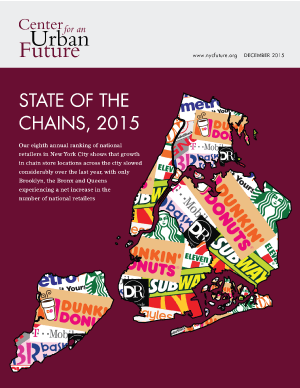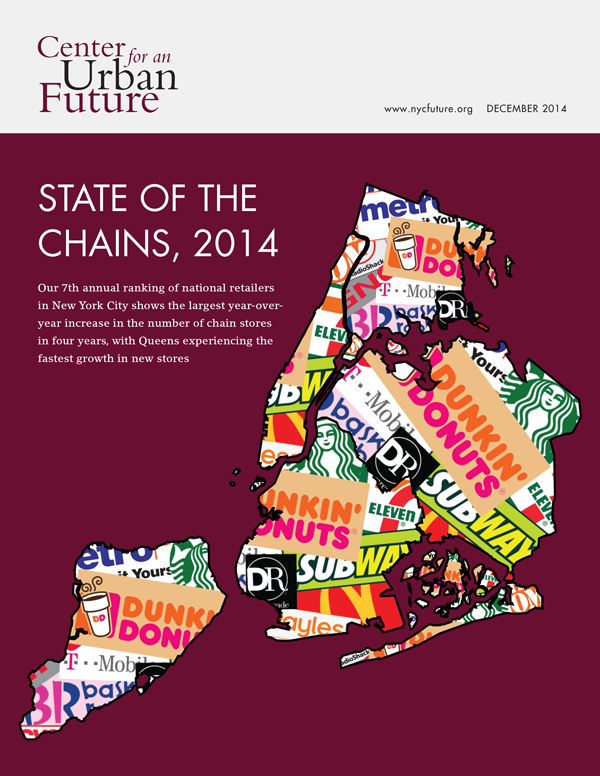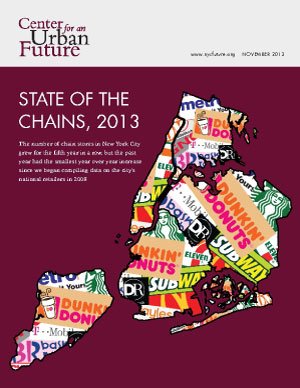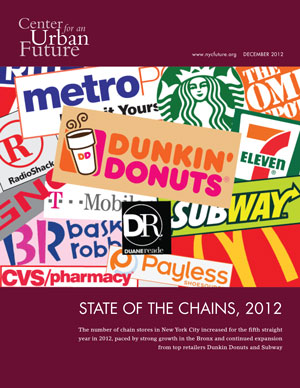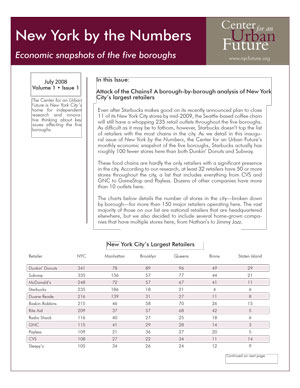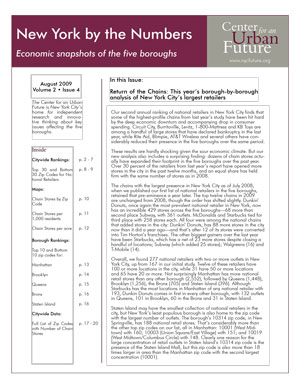Click here to download the full report.
The tenth annual ranking of national retailers in New York City by the Center for an Urban Future (CUF) shows a 1.8 percent increase in the number of store locations over last year.1 Though this is the ninth consecutive year with a net increase in national chain stores across the five boroughs, the growth was limited to a relatively small number of retailers.
In a year in which the challenges facing brick-and-mortar retail have burst into view, this report finds that New York’s national chains are not immune to the pressure. Although food establishments continue to show strong growth, retailers that compete most directly with online outlets—such as shoe and electronics stores—have experienced significant contractions. Overall, a fifth of all national retailers in the city closed stores in the past year, and only one-in-seven retailers on our list increased their footprint—the smallest share since we began keeping track a decade ago.
For the ninth consecutive year, Dunkin’ Donuts tops our list as the largest national retailer in New York City, with a total of 612 stores, a net increase of 16 stores since 2016—and 271 since 2008. But this year there is a new retailer in the second position on our list: MetroPCS now has 445 stores in the five boroughs, adding 119 locations over the past year and surpassing Subway, which is now third, with 433 stores.
Fast-casual dining chain restaurants in the five boroughs increased 105 percent over the past decade, from 141 to 289, while the number of fast-food restaurant chains grew 14 percent, from 1,107 to 1,261.2 And there are now 952 chain coffee shops in New York, 65 percent more than a decade ago, led by Dunkin’ Donuts. Food-related chains are responsible for 41 percent of the growth in national retailer locations in New York over the past ten years, the most of any category.
At the same time, there are fewer than half as many electronics shops in New York today as there were in 2008: down to 53 locations in the five boroughs, compared to 144 stores ten years ago. During the same period, the number of shoe retail chains decreased 16 percent, from 239 locations to 207.
CUF’s analysis shows that the 296 retailers listed in last year’s ranking expanded their footprint in New York City by 94 store locations, growing from a total of 7,223 stores in 2016 to 7,317 stores in 2017—a 1.8 percent increase. Chains gained locations in every borough except Staten Island. Only four retailers grew by more than 10 locations: Dunkin’ Donuts; Crumbs Bake Shop, which recovered last year from a near-bankruptcy under new ownership; and MetroPCS and T-Mobile, which are owned by the same company. MetroPCS grew faster than any other chain in this year’s survey. The cell phone retailer has now added far more stores since 2008 than any other brand (438, compared to second-place Dunkin’ Donuts’ 271 stores).
In addition to our customary analysis of the year-over-year change in the number and distribution of national retailer locations, this tenth edition also captures some trends for the entire past decade. In addition, we have organized the list of national retailers into business categories to break down broader trends across restaurants, pharmacies, clothing stores, and other segments of the retail industry.
Ten years of chain growth
In reviewing the past decade for New York’s national retailers, one thing is clear: the growth of restaurants and food retailers is leading the charge.
- The number of coffee chains expanded 65 percent since our first chains report was published in 2008, powered by the expansion of Dunkin’ Donuts and Starbucks, as well as local chains like Joe Coffee. During this ten-year period, chain coffee shops added 621 locations, more than any other category. Dunkin’ Donuts alone grew 79 percent.
- The number of fast-food restaurant chains expanded 14 percent since 2008. New-to-New-York chains like Checkers and Five Guys have led the growth, while industry leaders like McDonald’s and Subway have closed stores in recent years. There are now 1,261 fast-food restaurant locations in New York City, making them by far the most numerous type of national retailer in the city.
- The number of fast-casual dining chain restaurants in the five boroughs has more than doubled in the past decade, from 141 to 289. The growth of fast-casual chains like Chipotle and Chop’t is in addition to the growth in fast-food restaurants.
- The number of chain bakeries—such as Le Pain Quotidien and Panera Bread—has more than tripled over the past decade, from 55 to 161. This is in addition to the growth in fast-casual chains.
- Chains that specialize in frozen yogurt, such as Red Mango and 16 Handles, have expanded 283 percent—the largest growth rate of any retailer category. In 2008, there were 12 chain yogurt stores, and today there are 46. However, the city seems to have reached peak yogurt in 2014, with 57 chain yogurt locations.
- In contrast, ice cream chain stores have been steadily declining for a decade. The number of ice cream shops decreased from 376 in 2008 to 311 in 2017, a 17 percent drop.
- 7-Eleven grew from just 57 locations in 2008 to 140 in 2016.
- National grocers, namely Whole Foods and Trader Joe’s, increased their presence from just 5 locations in 2008 to 16 locations this year.
- The number of chain wholesale club locations, such as Costco and BJ’s, has more than doubled, going from six locations in 2008 to 13 in 2017.
Cell phone stores have dominated the consumer electronics market in the decade since the iPhone was first released.
- Mobile phone service chains added 621 locations in the past decade, going from 233 locations in 2008 to 854 in 2017.
- In 2017, mobile phone stores overtook clothing stores in terms of number of locations and are now second only to fast food restaurants.
- MetroPCS dominated the growth in mobile stores, going from 7 locations in 2008 to 445 this year—a 267 percent jump. The company’s growth was fueled by a 2013 merger with T-Mobile.
Other retailers competing directly with online marketplaces are showing signs of retreat.
- Traditional electronics retailers have not fared well. The biggest drop of any national retailer category was in electronics shops. Dragged down by the collapse of RadioShack following the company’s bankruptcy, there are now fewer than half as many electronics chains in New York as there were in 2008 (53 locations today, down from 144).
- Office supply chains have lost 25 percent of their locations, falling from 63 stores to 47.
- Shoe retail chains have decreased 16 percent, from 239 locations to 207.
What’s changed in 2017?
For the ninth consecutive year, Dunkin’ Donuts tops our list as the largest national retailer in New York City, with a total of 612 stores, a net increase of 16 stores since 2016. MetroPCS has overtaken Subway to become the second-largest national retailer in the city, with 445 stores, after gaining 119 stores over the past year. Rounding out the top ten national retailers in New York are Subway (with 433 stores), Starbucks (317), Duane Reade/Walgreens (260), T-Mobile (236), Baskin Robbins (221), McDonald’s (215), Rite Aid (179), and CVS (149).3 Like last year, there are 12 retailers with at least 100 stores across the city.
The vast majority of national retailers—66 percent—maintained the same number of locations as last year, in contrast to the year before, when just one-third of all retailers remained flat. Only one in seven national retailers on this year’s list increased their footprint in the city by at least one store over the past year, compared to one out of five last year—the smallest share since we began keeping track a decade ago. About a fifth of all chains closed locations in the past year, including three chains that shuttered all New York City locations: Second Time Around and American Apparel, both clothing retailers facing stiff online competition, and Bally Total Fitness, which went out of business.
Notably, after years of growth, chain pharmacies have begun to contract. Chain pharmacies, which include Duane Reade/Walgreens, Rite Aid, and CVS, lost 53 locations since last year and now have a total of 588 locations. This number is just 1 percent above the number of chain pharmacy locations in 2008. This is largely because Duane Reade/Walgreens has been consolidating locations since its 2010 merger and is closing 600 locations nationwide in preparation for a major acquisition of stores from Rite Aid.
Manhattan still has more national retailer store locations than any other borough, through Brooklyn has been slowly eroding Manhattan’s share of the city’s national retailers. Over the past five years Queens’ share of the city’s chains has remained steady at 23 percent, the Bronx’s share has remained at 12 percent, and Staten Island’s at 6 percent. But Manhattan’s share has dropped from 39 percent in 2012 to 37 percent in 2017, while Brooklyn’s share has increased from 20 percent to 22 percent.
Brooklyn saw the biggest percentage increase in the number of chain store locations, growing 3.1 percent from 1,540 locations in 2016 to 1,587 locations in 2017. In the Bronx the number of locations increased 1.8 percent, from 891 locations in 2016 to 907 locations in 2017. Queens and Manhattan each saw a 0.9 percent increase, from 1,665 to 1,680 locations in Queens and 2,710 to 2,734 in Manhattan. Staten Island saw a decline of 1.9 percent (from 417 to 409 locations).
Starbucks has more stores in Manhattan than any other national retailer, with 223 locations. In Brooklyn, Queens, and Staten Island, Dunkin’ Donuts tops the list—it has 187 stores in Queens, 161 in Manhattan, 139 in Brooklyn, and 36 on Staten Island. But for the first time since we have been tracking this data, Dunkin’ Donuts’ lead in the Bronx has been overtaken by MetroPCS, which has 98 locations in the Bronx compared to Dunkin’ Donuts’ 89. In Brooklyn, MetroPCS is just one store shy of tying with the longtime leader. MetroPCS is the top cellular phone services retailer in each of the five boroughs.
Among the large pharmacy chains, Rite Aid is the top pharmacy in the Bronx, Brooklyn, and Queens. Duane Reade/Walgreens is the most numerous in Manhattan, and CVS has the top spot on Staten Island. After Dunkin’ Donuts, Subway is the most popular fast-food chain in each of the five boroughs.
Though both national retailer expansions and contractions were rarer this year than in previous years, there are still some areas of growth. The following retailers experienced significant store growth over the past year:
- MetroPCS: 445 locations, up from 326 last year and just 7 locations in 2009
- Dunkin’ Donuts: 612 locations, up from 596 in 2016 and 341 in 2008
- T-Mobile: 236 locations, up from 223 in 2016 and 82 in 2008
- Crumbs Bake Shop: 22 locations, up from 10 in 2016 and 2008
- Children’s Place: 38 locations, up from 30 in 2016 and 21 in 2008
- Pret a Manger: 50 locations, up from 42 i n 2015 and 15 in 2008
The following retailers downsized significantly over the past year, but still have a presence in the city:
- Duane Reade/Walgreens: 260 locations, down from 303 in 2016 and 264 in 2008
- RadioShack: 3 locations, down from 35 in 2016 and 116 in 20084
- Payless: 74 locations, down from 95 in 2016 and 109 in 2008
- Hale and Hearty Soups: 23 locations, down from 31 in 2016 and 20 in 2008
Most national retailers were launched or are headquartered outside of New York City. However, New York City–based national chains are responsible for more than half of all store locations in four different retail categories. Fully 97 percent of chain health club locations belong to New York City–based chains like Equinox and New York Sports Club, as well as 73 percent of chain tea shop locations, 72 percent of optical good and optometrist chain locations, and 51 percent of chain retail bakery locations. In contrast, only 2 percent of chain coffee shop locations are of national retailers based in New York City as well as 7 percent ice cream chain locations and 10 percent of fast-food restaurant locations.
Borough Trends
Our report also charts retailer trends within the boroughs. We discovered several interesting trends this year:
- MetroPCS added 119 new stores citywide, the greatest increase of any chain. The company opened 34 new stores in Queens alone, the most of any chain in a single borough.
- Duane Reade/Walgreens closed 20 stores in Manhattan, the largest drop for any chain in any borough.
- Overall, 169 retailers have more of their stores in Manhattan than any other borough, 56 retailers have more of their stores in Queens, 52 in Brooklyn, 15 in the Bronx, and three have the most on Staten Island.
- Only 133 out of the 296 national retailers with locations in New York City had at least one location in the Bronx (45 percent), compared to 261 (88 percent) in Manhattan, 204 (69 percent) in Queens, 187 (63 percent) in Brooklyn, and 154 (52 percent) on Staten Island.
- Fifty retailers have no locations outside Manhattan. In addition, four have their only locations in Queens: Gold’s Gym, Bare Escentuals, Puma, and Easy Spirit, and two retailers have their only locations on Staten Island: Stride Rite and Build-A-Bear Workshop.
Every year, we add new national retailers to our ranking. This year, we added 34 new retailers: Adidas, Advance Auto Parts, Aldi, Argo Tea Coffee, Autozone, Baked By Melissa, Bareburger, Blue Bottle Coffee, Bonobos, Danice Stores, Dig Inn, Edible Arrangements, Fabco Shoes, Fresh & Co, Gregory’s Coffee, Home Goods, Insomnia Cookies, Juice Press, Kiehl’s, Little Caesar’s, Lodi’s Gift, Napa Auto Parts, Oshkosh B’gosh, Paris Baguette, Petco, PetSmart, Planet Wings, Pollo Campero, Pressed Juicery, Rainbow, Shake Shack, TJ Maxx, Swarovski, Warby Parker, and Wingstop. Including these new retailers, our complete list of 349 retailers has 7,873 store locations across the five boroughs.
Zip Code Trends
Like last year, the 10314 zip code, home to the Staten Island Mall, took the top place for highest number of national retailer locations at 173, down from 183 last year. Manhattan’s 10001 zip code in Midtown/Koreatown that is home to the Manhattan Mall and the Herald Square shopping areas is tied with 10003 in Manhattan’s East Village for the second highest number of locations, at 162, down from 167 and 160, respectively, last year. Zip code 11201 in Brooklyn Heights/Downtown Brooklyn has the largest number of national retailer locations in that borough at 145, up from 138 last year. In Queens, zip code 11373 in Corona/Elmhurst, home to the Queens Center Mall, has the highest number of chain stores in that borough (131). In the Bronx, zip code 10451 in High Bridge/Morrisania has the highest number of chain stores of any zip code in that borough (83).
Also like last year, increases in retailer locations by zip code were modest. The biggest increase was in the 10007 zip code in Lower Manhattan/Tribeca, which saw an increase of 12 locations, followed by a 10-location increase in 11354 (Flushing, Queens). In the Bronx, 10451 (High Bridge/Morrisania) saw the greatest increase (8 locations), in Brooklyn, 11201 (Brooklyn Heights) has the largest increase, at seven locations, and 10301 (Tompkinsville/New Brighton/Saint George) had the largest increase on Staten Island (3 locations).
Manhattan still has the largest share of national retailer locations in the city at 37 percent of all locations, followed by Queens at 23 percent, Brooklyn at 22 percent, the Bronx at 12 percent, and Staten Island at 6 percent. Manhattan also has the highest concentration of chain stores at 115 locations per square mile. The remaining boroughs have significantly fewer chain stores per square mile: Brooklyn (36), Queens (15), the Bronx (11), and Staten Island (7). Overall there are 24 chain stores per square mile and 1,169 New York City residents for every chain store location in the city.
The remainder of this report details a comprehensive ranking of national chains in New York city by their number of store locations, the number of store locations in each zip code, zip codes with the most and least number of chains, and zip codes with the most and least number of chains by borough.
The largest national retailers are expanding all over the city. The following shows where the ten largest retailers added locations or contracted over the past year. For example, the number of Dunkin’ Donuts locations increased by 16 stores citywide since last year, including an increase of eight stores in Queens, four each in the Bronx and Manhattan, one in Brooklyn, and a loss of one on Staten Island.
Download the full report.
1. CUF defines a “national retailer” as one that has at least two locations in New York City and at least one location outside the city limits.
2. For the purposes of this analysis, the category of fast-casual restaurants includes limited-service restaurants with made-to-order food and seating, such as Chipotle Mexican Grill and Chop’t Salad, as well as casual chain restaurants with table service, such as Applebee’s and IHOP. The category of fast-food restaurants includes traditional limited-service and/or takeout-focused chains such as McDonald’s, Subway, Burger King, and Popeyes.
3. Duane Reade was acquired by Walgreens in 2010. Although there are still Duane Reade- and Walgreens-branded stores throughout the city, we counted these stores together.
4. RadioShack has since closed its last three stores in New York.

